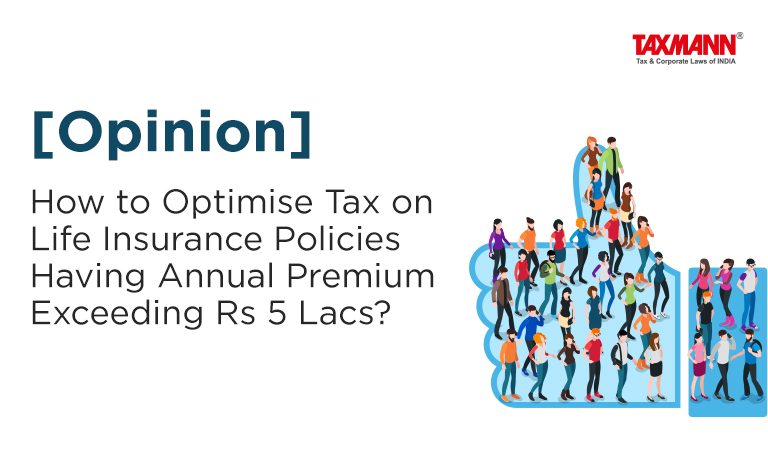[Opinion] How to Optimise Tax on Life Insurance Policies Having Annual Premium Exceeding Rs 5 Lacs?
- Blog|News|Income Tax|
- 2 Min Read
- By Taxmann
- |
- Last Updated on 21 August, 2023
Mayank Mohanka – [2023] 153 taxmann.com 455 (Article)
The Finance Act 2023 has ended the ‘tax-holiday’ glory of the maturity proceeds of high-ended life insurance policies/endowment plans, requiring payment of annual premium in excess of Rs 5 lacs. The section 10(10D) of the Income Tax Act has been amended to provide that the maturity proceeds received under a life insurance policy, (other than ULIPs), issued on or after 1.4.2023, shall not be exempt, if the premium payable in any year, during the term of such policy, exceeds Rs 5 lakhs.
The amended section also stipulates that if the policy holder holds and pays premium in respect of multiple life insurance policies, issued on or after 1.4.2023, the exemption from income tax in respect of the maturity proceeds shall be available only in respect of such policies where the aggregate annual premium does not exceed Rs 5 lakh, during the term of any of such policies. It is pertinent to mention here that the clubbing or aggregating of annual premium for the purpose of determining the threshold annual premium limit of Rs 5 lakhs in respect of multiple life insurance policies, is to be done only for those life insurance policies which have been issued on or after 1.4.2023. Further the maturity proceeds of such life insurance policies, have been made taxable under the head income from other sources under a new section 56(2)(xiii).
Amidst such taxing times for the high-ended life insurance policies, the CBDT has brought in some respite by way of its Circular No. 15 of 2023 dated 16.8.2023. This Circular contains guidelines to remove difficulty in practical implementation of the amended provisions of section 10(10D), concerning the taxability of maturity proceeds of life insurance policies, issued on or after 1.4.2023. The Circular also contains practical examples for better understanding and clarity of the stakeholders, in this respect.
Click Here To Read The Full Article
Disclaimer: The content/information published on the website is only for general information of the user and shall not be construed as legal advice. While the Taxmann has exercised reasonable efforts to ensure the veracity of information/content published, Taxmann shall be under no liability in any manner whatsoever for incorrect information, if any.

Taxmann Publications has a dedicated in-house Research & Editorial Team. This team consists of a team of Chartered Accountants, Company Secretaries, and Lawyers. This team works under the guidance and supervision of editor-in-chief Mr Rakesh Bhargava.
The Research and Editorial Team is responsible for developing reliable and accurate content for the readers. The team follows the six-sigma approach to achieve the benchmark of zero error in its publications and research platforms. The team ensures that the following publication guidelines are thoroughly followed while developing the content:
- The statutory material is obtained only from the authorized and reliable sources
- All the latest developments in the judicial and legislative fields are covered
- Prepare the analytical write-ups on current, controversial, and important issues to help the readers to understand the concept and its implications
- Every content published by Taxmann is complete, accurate and lucid
- All evidence-based statements are supported with proper reference to Section, Circular No., Notification No. or citations
- The golden rules of grammar, style and consistency are thoroughly followed
- Font and size that’s easy to read and remain consistent across all imprint and digital publications are applied








 CA | CS | CMA
CA | CS | CMA


